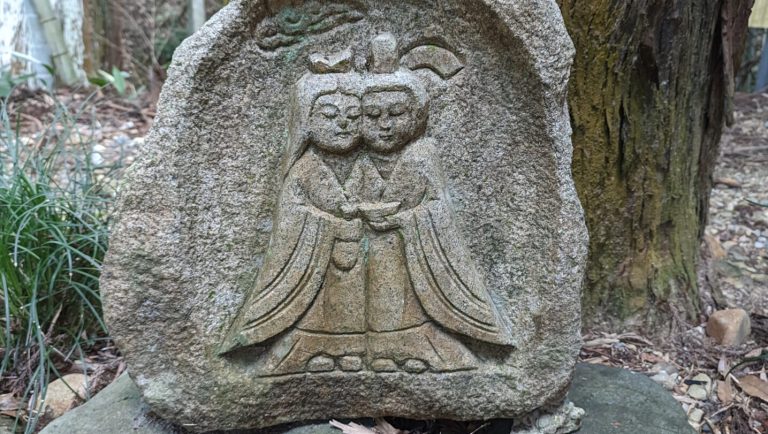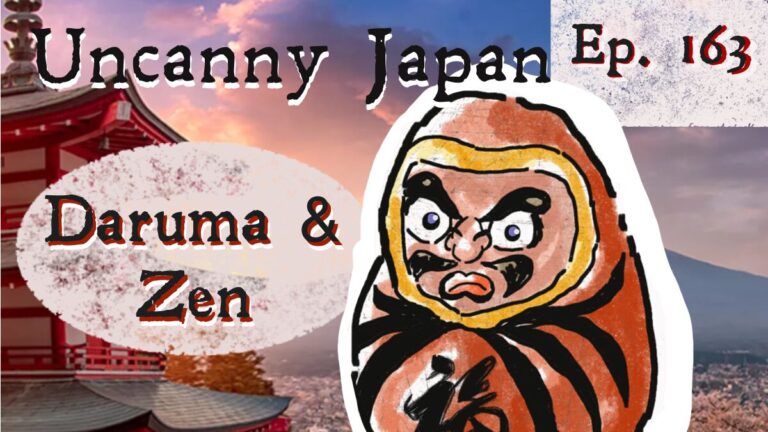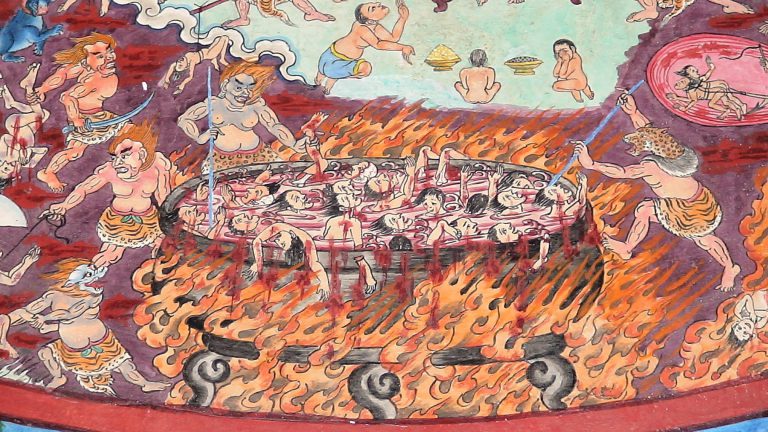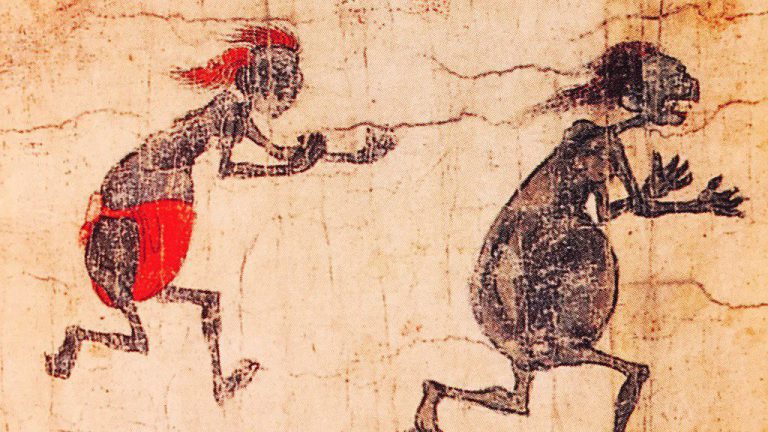Hey hey, this is Thersa Matsuura and you’re listening to Uncanny Japan.
Have you ever wondered who protects you? What otherworldly or godly spirit follows you through life, keeps you safe, watches you sleep?
In the west, we have patron saints. A saint that’s been assigned to you because of your name. Or I just learned if you happen to have a name or names that don’t have a saint ascribed to them, your birthday. Because every day of the year is the feast of at least one saint. Voila, your patron saint.
But what about Japan? Is there a patron Buddha?
About 25 years ago I was sitting at the dinner table with my in-laws and my mother-in-law pulled out a very complicated-looking diagram. She ran her finger down it and said. “Terrie, let’s find out who your protecting god is.”
I said, sure!
So today let’s find out who your protecting Buddhist deity is. We all have one and it doesn’t matter what kind of name you have at all.
Intro:
Hey hey, how are you? Doing well. As well as can be expected? Yeah, me, too.
I’m going to tell you who is protecting on the Buddhist side of things, a little about that diety’s character, and how to identify it if let’s say you come across a statue at at temple or want to buy a small effigy or if it, I don’t know, shows up in your dreams or something. In a good way, not a creepy way. Buddha’s don’t do that.
The method I’m using of finding your protecting god is the one I’ve seen used everywhere. So I think I can safely say it’s the most common. I’m not saying there isn’t another one out there, just I didn’t find it. This one kept popping up.
Japanese Saying About Buddha
Let me start by telling you a saying: “Umare tsuki hotoke sama to go en ga musubareteimasu.” We are all born with a connection to the Buddha.
But there isn’t just ONE Buddha. Well, there is that ONE Buddha (Siddhārtha Gautama), the one you’re thinking about. But there are also quite a few different other types of, well, for lack of a better word, gods. And everyone one of us is born and are assigned one to guide, protect, and help us out throughout our lives. Which is very nice.
And lucky for us the deity isn’t assigned by name. So instead of names, they match up with our eto or animal zodiac. Do you remember what animal you are? That’s okay. I’ll run through the years before each one, in case you forgot.
Types of Buddhas – Bosatsu and Nyorai (and Myō ō)
Something to note is that there are different kinds of Buddhist deities and statues. In general, there’s a bosatsu and a nyorai. You might know bosatsu as Bodhisattva if you’re studying Buddhism. An almost enlightened being. The reason they aren’t enlightened is because they chose to keep a single or a couple attachments, so they don’t go full enlightenment and can remain nearby and help as many people as possible to reach their own nirvana. Which is also very nice. Kannon or Kwan Yin in Chinese is a bosatsu.
A second is a nyorai. Which is a being who is a version of a Buddha after attaining enlightenment.
In general, a bosatsu will be more fancifully dressed (see attachments) and a nyorai is usually more austere, dressed in simple robes.
There are also myo-o. Myo-o aren’t manifestations of the Buddha at all but minor gods who live in heaven. You can more easily see the Hindu influence in their image. They’re protectors of Buddhism and look fierce, have weapons, and over all just wicked cool.
But for all intents and purposes, it doesn’t matter if you have a bosatsu, nyorai or myo-o as your patron Buddhist saint. They’re all care about you, personally.
So let’s go through the animal zodiac on at a time and let me introduce you to your god.
Year of the Rat are Senuju Kannon
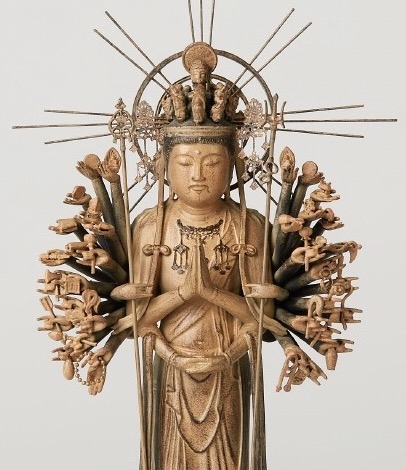
1. Year of the Rat people, raise your hands. Were you born in the year 1948, 1960, 1972, 1984, 1996, 2008, or 2020? Congratulations you’re guardian Buddha is Senju Kannon Bosatsu / 千手観音菩薩 or the 1,000-armed Kannon. She’s the statue you see with all the arms fanning out at her sides, obviously.
It’s also said she has a thousand eyes, inside her hands.
If you find a statue or image of Senju Kannon and you decide you want to count arms, I’ll save you some trouble. There are usually 42 or fewer. Two main, regular arms, and then twenty little bitty arms on either side, often holding sacred objects or making mudras, hand gestures. But don’t worry. That’s not cheating. Actually, each arm will save the beings of 25 worlds, 25 times 40 equal 1,000. So there. Plus two extra!
But in earlier images of Senju Kannon like the ones in Toushoudaiji in Nara and Fujidera in Osaka, there they tried to actually get to 1,000 arms.
Senju Kannon is best known for removing suffering, helping recover from illness, rebirth, and just making this world a better place. She is also helpful to pray to if you have eye problem. It’s said she can transform into 33 different forms in order to help the suffering.
Year of the Ox and Tiger are Kokuzou Bosatsu
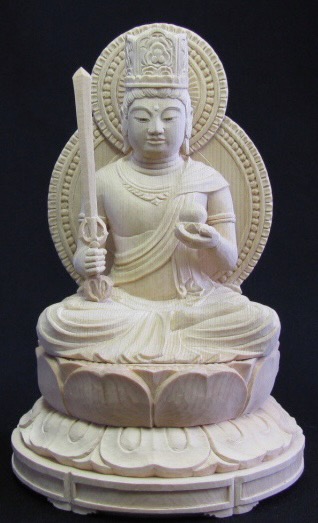
2. Year of the Ox and Year of the Tiger people, you’re teamed together. Oxes are years: 1949, 1961, 1973, 1985, 1997, 2009, 2021 and Tigers are: 1950, 1962, 1974, 1986, 1998, 2010, 2022
Congratulations, the Kokuuzou Bosatsu / 虚空蔵菩薩 is watching over you.
Kokuuzou Bosatsu could literaly be translated at Space Repository or Sky Repository because his wisdom is as boundless as the sky. But let’s instead use the less weird name the Bodhisattva of Wisdom and Memory. This bosatsu is special to the Shingon Buddhism, an esoteric sect that I personally quite love. He can appear in different Buddha looking forms. You might find him holding a wish-granting jewel or a lotus stem that has the wish-granting jewel on top, and other times even a sword.
Your Kokuuzou Bosatsu helps with improving your grades (ie. bestowing intelligence), improving your memory, clearing your head, making for a prosperous business and overall just improving your skills. Kokuuzou is also worshipped as the patron of craftspeople and artisans. Maybe you can make good use of that wish-granting jewel, too, while you’re at it.
Year of the Rat are Monju Bosatsu
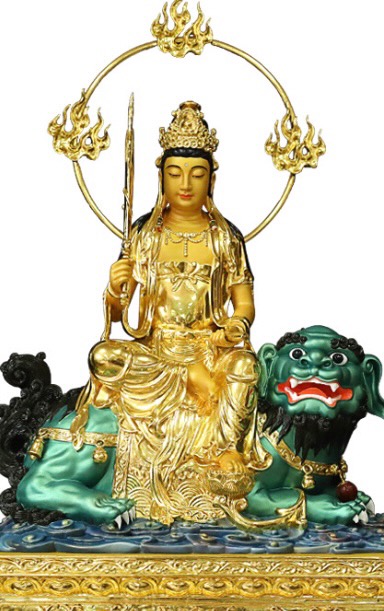
3. Rabbit people, I’m looking at you now. Were you born in any of the years 1939, 1951, 1963, 1975, 1987, 1999, 2011 then yay! You get to be watched over by Monju Bosatsu / 文殊菩薩
If you thought Kokuuzou was smart, Monju is thought to be the smartest of all the bosatsu and is approached when you want to gain clarity of wisdom and academic achievement, and if you want to be a good calligrapher.
He was also one of the original disciples of the Buddha and, therefore, can be found represented in artwork from India, Nepal, Tibet, China, and of course Japan.
In Japan to identify an image of Monju Bosatsu, you might find him sitting on a roaring lion or shishi. Where in one hand he’ll wield the Sutra of wisdom in one hand and a sharp sword in the other. He uses the sword to cut through illusion and bring light to the unenlightened mind.
If you didn’t think he was awesome enough, in Zen it is Moju Bosatsu who is the deity of the meditation halls and in the Tendai Sect, he is the deity of the kitchen and dining halls.
There is an old saying: Sannin yoreba, monju no chie / 三人寄れば文殊の知恵. if three people come together, the wisdom of Monju. My guess is that’s a better way of saying three minds are better than one.
Year of the Dragon and Snake are Fugen Bosatsu
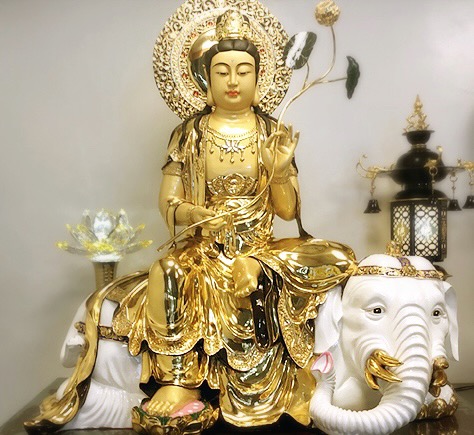
4. Bring me the dragon and snake people. You seemed kind of related, dragon and snakes, so you also get to be your own reptilian group. Real quick: Dragons would be born in:1940, 1952, 1964, 1976, 1988, 2000, 2012 and Snakes, you’re: 1941, 1953, 1965, 1977, 1989, 2001, 2013
You, my serpentine friends, are represented by Fugen Bosatsu / 普賢菩薩. Fugen Bosatsu is the Bodhisattva of Universal Goodness, Virtue and Worthiness. He teaches that action and conduct are equally important.
Fugen is also the patron of women. In Japan’s Heian Era women of the court adopted a type of Buddhism that concentrated on the Lotus Sutra (because it cared about the salvation of women). Fugen appears in this sutra which led naturally to him becoming a protector of women.
Fugen knows Monju. Actually, they both studied under the original Buddha and if you ever see a picture of Buddha with two disciples on either side, one is Monju the other is Fugen. Where Monju is all about wisdom and enlightenment, Fugen has taken up the mantel of meditation and practice.
You can recognize your god because he just might be riding an elephant with hands pressed together in prayer. That elephant might be white and it might have six tusks. Those represent overcoming your attachments to the six senses. Or sometimes he foregoes the elephant and just sit on a lotus petal.
Year of the Horse are Seishi Bosatsu
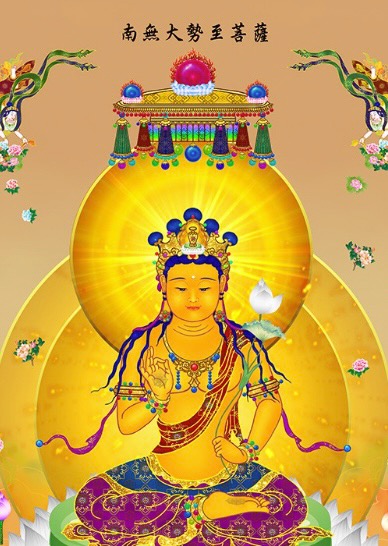
5. Horse people please stand up. Not that I think you were sitting down, horses usually stand, don’t they? If you were born in the years: 1942, 1954, 1966, 1978, 1990, 2002, 2014, that’s you!
And your protector deity is Seishi Bosatsu / 勢至菩薩 Seishi, like the others began in India but didn’t really hit it off there. In China and Japan, though, he found a home, especially with the Pure Land Buddhists. Alongside Kannon, Seishi is an attendant to the Amida Buddha and part of the Amida Triad. Which sounds like an organized crime syndicate, but it’s not!
Sadly, you don’t see Seishi representing by himself. In Japan, at least, you’ll almost always find him in the Amida Sanzon / or Amida Triad. Not a gang. But when you do find him, he’ll have a small water vase which symbolizes (you guessed it) wisdom. One idea as to why Seishi wasn’t and isn’t more popular is because of Monju. Mr. Wisdom. He kind of stole the show.
This Bodhisattva helps to achieve clear wisdom, home security, disaster relief and good luck. He also illuminates the world with the light of wisdom and saves people from suffering and confusion. And has tremendous power and protects the goodness in people.
Year of the Monkey and Sheep are Dainichi Nyorai
6. Next we have, Team Monkey and Sheep another curious pairing. Monkeys: 1944, 1956, 1968, 1980, 1992, 2004, 2016. Sheep: 1943, 1955, 1967, 1979, 1991, 2003, 2015
Monkey-Sheep are guarded and watched over by Dainichi Nyorai / 大日如来 The Great Sun or the Cosmic Buddha and supreme deity of the Esoteric, tantric sects. The most important Buddha in Shingon and is said to be everywhere and everything, all the other Buddhas are just emanations for Dainichi. So the big kahuna.
Even though earlier I said Nyorai are simply dressed, not so with Dainichi. Dainichi is gussied up. With hair nicely arranged, a crown on his head, and lots of jewels and ornaments adorning his body. So you might mistake him for a bosatsu. But look for the hand gesture called the mudra of the six elements. This is something you might see ninjas doing in manga or anime. The mudra of six elements is when you take the index finger of your left hand and grasp it with your right hand.
As for what he offers, well, how about illuminating everything in the world, healing, prosperity, and last but certainly not least: calmness in the world
A neat bit of trivia. Dainichi Nyorai has been worshipped from as early as the late 700s, in the Heian Era. But before that he as called Birushana. Birushana is from the the sanskrit word Vairocana. That version of Dainichi was made into a giant statue in 752 in Nara and is the largest bronze statue in the world. Which is, in fact, the Big Buddha of Nara, the Nara Daibutsu! So if you’ve ever been there or seen pictures of it and you happen to be Team Monkey or Sheep. He’s watching out for you. And me, because I’m a monkey.
Year of the Chicken are Fudo Myou Ou
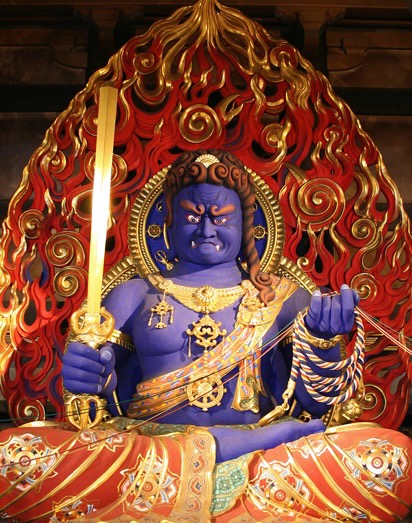
7. Next, Chicken people come gather round. Were you born in the years: 1945, 1957, 1969, 1981, 1993, 2005, 2017
You lucky poultry are under the stern gaze of Fudo Myou Ou / 不動明王. Personally I’m a tad drawn to this fellow recently. Where up until now we’ve had peaceful, serene-faced Bosatsu and Nyorai, now we got the wrathful, brawny Fudoo Myoo Oo. Interestingly, Fudoo Myoo Oo is said to be the personification of Dainichi, but also Dainichi’s messenger.
Fudou Myoo Oo means the immovable one and boy is he tough. Angry scowling face aside, he’s carrying a devil subduing sword that can also cut through ignorance in one hand and a rope to tied up demons in the other. Often you see him with a third eye, too. Look for his fangs. One will point up, the other down. He’ll be surrounded by flames.
What can he help with? Well, beside removing obstacles, he gives blessings from disasters, victories in battle, driving away demons, protecting those who are training in the buddhist tradition, will bring you money
Don’t let his angry face food you, he want to cut away the evil and guide you who are suffering from worldly desires to the path of Buddhism. Turning anger into salvation for a thousand years.
Year of the Dog and Wild Boar are Amida Buddha
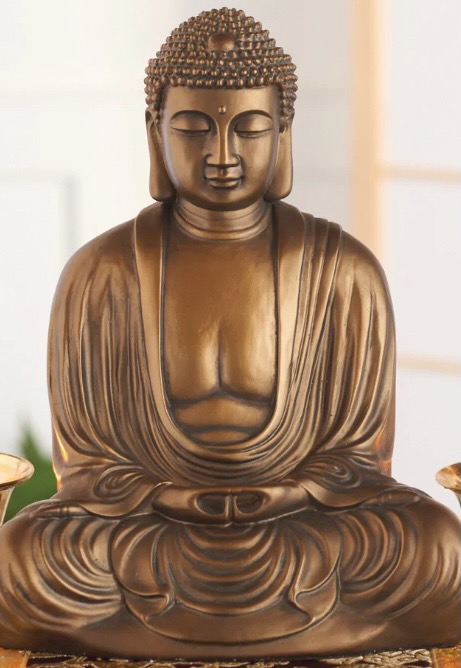
8. Lastly, Dog and Wild boar people you have arrived. Dogs being those born in 1946, 1958, 1970, 1982, 1994, 2006, 2018 and Wild Boars: 1947, 1959, 1971, 1983, 1995, 2007, 2019
Remember the triad of Amida? Kannon and Seishi on either side of Amida Buddha /( Amida Nyorai 阿弥陀如来)? Well, puppies and piggies get Amida himself. The big guy. The biggest guy. Dainichi Nyorai is the top in the esoteric traditions, but Amida is just top overall. For example to Pure Land Buddhists, Jodo shu, Amida has beaten out the historical Buddha as most popular. Remember that the Pure Land Buddhists are the most popular in Japan today.
Interestingly, Buddhism wasn’t for the regular people for a very long time. Remember when I talked about court women in the Heian Era worshipping Fugen? That was the court women. It wasn’t until Jodo-Shu, Pure Land Buddhism that suddenly the faith became accessible. No more fancy, complicated rituals, two monks, Honen and Shinran, taught that all you needed to do was chant the name of Amida Buddha with all your heart and you, too, could be reborn in a Buddhist paradise. That prayer is: Namu Amida Butsu.
The Big Buddha in Kamakura is this one, Amida. But also he’s a whole lotta places. And in a whole lotta different forms. But one way to spot him is the meditation mudra, hands in lap with thumbs touching.
Aside from coming down and whisking you to the western paradise after your death, what can Amida do? Well, Amida is very gentle and all-accepting. He can bring you long life and tranquility and save you from hardships, too.
And sometimes you’ll find him riding a peacock or a goose.
Okay, I’ll end here. Now everyone know who their own patron Buddhist deity is. Speaking of patrons, thank you patrons! We reached 300 and I’m so grateful and I want to do something different and special for you all. Right now I’m doing research on Japanese wolves. Which are extinct by the way. Very sad. But they used to be a thing and I found an old wolf temple a couple hours from my house. So I’m going to visit there and take video, photos, binaural sounds if there are cool sounds, it is way in the mountains. Then I’m going to put that up for patrons. So thank you all again so much and if you have any other ideas of something special you would like, let me know.
Thank you all for listening! Take care and stay well, give a little nod to your protecting deity and I’ll talk to you real soon.
Bye bye

